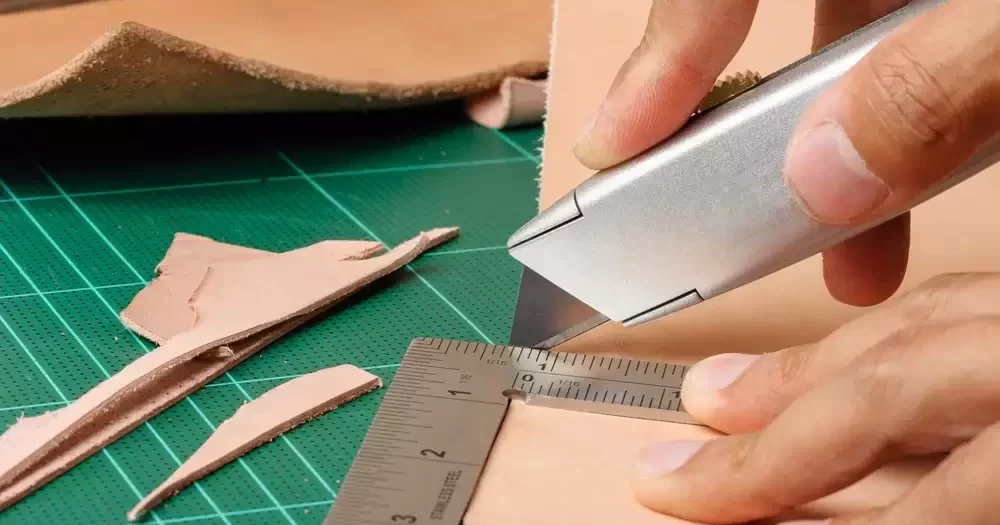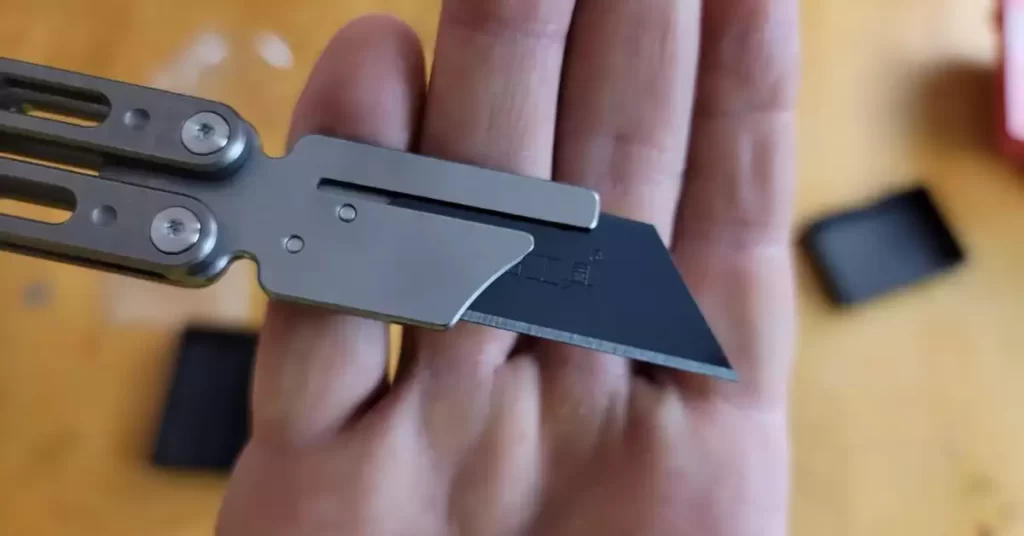Utility blades are an essential tool for a wide range of tasks, from simple cutting jobs to intricate craftwork. The material used to construct these blades plays a significant role in their overall performance and longevity. With various blade materials available, choosing the right one can be overwhelming, and understanding their differences is crucial.
Carbide and titanium utility blades are two popular choices for their unique properties and advantages. Carbide blades are known for their long-lasting sharpness and durability, while titanium blades offer lightweight and corrosion-resistant characteristics.
As you continue reading, you’ll learn about the factors to consider when choosing between carbide and titanium utility blades. This comprehensive guide will help you make an informed decision based on your specific needs and preferences, ensuring that your blade choice delivers the best possible performance.
Titanium vs Carbide – Comparison Table
| Feature | Carbide Utility Blades | Titanium Utility Blades |
| Composition | Tungsten carbide compound | Titanium alloy |
| Sharpness | Very sharp | Less sharp |
| Durability | High | Moderate |
| Wear Resistance | Excellent | Good |
| Flexibility | Limited | High |
| Corrosion Resistance | Good | Excellent |
| Longevity of Cutting Edge | Long-lasting | May dull quickly |
| Weight | Heavier | Lightweight |
| Cost | More expensive | Relatively expensive |
| Best Applications | Heavy-duty cutting tasks, abrasive materials | Tasks requiring flexibility, precision, and corrosion resistance |
| Blade Replacement | Less frequent | More frequent |
Carbide Utility Blades
Definition and Composition of Carbide Blades
Carbide blades are made from a compound called tungsten carbide, a material consisting of equal parts tungsten and carbon atoms. The carbide is combined with a binding material, typically cobalt, to create a hard, wear-resistant material that can maintain its sharpness for an extended period.
Advantages of Carbide Blades
Long-lasting Sharpness
One of the primary benefits of carbide utility blades is their ability to retain their sharpness longer than other blade materials. The hardness of tungsten carbide allows it to withstand wear and maintain a sharp edge, resulting in less frequent blade replacements and improved productivity.
Durability
Carbide blades are known for their durability, which means they can handle heavy-duty cutting tasks without breaking or chipping. This durability is due to the high resistance of tungsten carbide to wear and its ability to withstand high pressure.
Resistance to Wear and Chipping
Carbide blades demonstrate exceptional resistance to wear and chipping, even when used in demanding applications. This attribute is crucial for those who frequently work with abrasive materials, as it can extend the blade’s lifespan and maintain consistent cutting performance.
Disadvantages of Carbide Blades
Brittle Nature
Despite their many advantages, carbide blades can be brittle. This means that they may be more susceptible to breaking or chipping under excessive force or when used on highly rigid materials. It’s essential to be cautious when using carbide blades for cutting tasks that require significant force or involve hard substances.
Cost
Carbide blades tend to be more expensive than other blade materials, primarily due to the high cost of tungsten carbide production. While their durability and long-lasting sharpness may offset this expense, budget-conscious users may prefer other blade materials.
Limited Flexibility
Carbide blades offer limited flexibility due to their rigid nature, which can be a drawback for tasks that require a degree of bending or adaptability. In these cases, other blade materials, such as titanium, might be a better choice.

Titanium Utility Blades
Definition and Composition of Titanium Blades
Titanium utility blades are made from a titanium alloy, typically composed of titanium and other metals such as aluminum and vanadium. These alloys offer a unique combination of strength, lightweight, and corrosion resistance, making them ideal for various applications.
Advantages of Titanium Blades
Lightweight
One of the most notable benefits of titanium utility blades is their lightweight nature. The lower density of titanium compared to other metals allows for easier handling and reduced fatigue during prolonged use.
Corrosion Resistance
Titanium blades are highly resistant to corrosion, making them suitable for use in environments where moisture or chemicals are present. This resistance ensures the blade’s longevity and consistent performance, even when exposed to corrosive substances.
Flexibility and Toughness
Titanium utility blades offer a unique combination of flexibility and toughness, allowing them to withstand bending forces without breaking. This quality makes them suitable for tasks that require some degree of adaptability, such as cutting materials with irregular shapes or contours.
Berkling Titanium Utility Knife Blades
- ✅ SK2H utility blade entirely plated with titanium to achieve maximum corrosion resistance and extra durability.
- ✅ Hardened premium SK2H carbon steel sharpened with laser then plated with titanium is 3x sharper and 15x more durable...
- ✅ Standard T-shape 2 notch & 2 side cutting. 0.6mm/ 0.03" blade thickness is thicker and extra durable...
Disadvantages of Titanium Blades
Less Sharpness Compared to Carbide
While titanium blades offer numerous advantages, they tend to be less sharp than carbide blades. This reduced sharpness can affect cutting performance, particularly in applications where precision and clean cuts are essential.
Potential for Dulling Quickly
Titanium blades may dull more quickly than carbide blades, especially when used to cut abrasive materials. This may result in more frequent blade replacements, which could be a drawback for users who value long-lasting cutting performance.
Cost
Titanium blades can be relatively expensive, primarily due to the cost of producing titanium alloys. Although their lightweight and corrosion-resistant properties may justify the expense for some users, those on a tight budget may find it challenging to justify the higher price.
Comparison: Carbide vs Titanium Utility Blades
Cutting Performance
When it comes to cutting performance, carbide blades generally outperform titanium blades. Carbide blades offer superior sharpness and longer-lasting cutting edges, while titanium blades tend to be less sharp and may dull more quickly. However, titanium blades provide greater flexibility and toughness, making them suitable for specific applications where adaptability is crucial.
Durability and Longevity
Both carbide and titanium utility blades offer impressive durability, but they excel in different aspects. Carbide blades boast long-lasting sharpness and resistance to wear and chipping, while titanium blades demonstrate excellent corrosion resistance and flexibility. The choice between the two will largely depend on the specific cutting tasks and environmental factors involved.
Versatility in Various Applications
Carbide blades are best suited for applications that require consistent cutting performance, durability, and resistance to wear. They excel in heavy-duty cutting tasks and when working with abrasive materials. On the other hand, titanium blades are ideal for applications that demand lightweight, corrosion resistance, and flexibility. They perform well in tasks that require adaptability and precision in cutting irregular shapes.
Cost-effectiveness
While both carbide and titanium blades can be relatively expensive, the cost-effectiveness of each depends on their specific use. Carbide blades may offer better value for users who prioritize long-lasting sharpness and durability, while titanium blades may be a more cost-effective choice for those who value lightweight and corrosion-resistant properties.

Factors to Consider When Choosing Utility Blades
Purpose of Use
Understanding the intended use of the utility blade is crucial when deciding between carbide and titanium materials. Consider the specific cutting tasks, the materials being cut, and the required level of precision.
Frequency of Blade Replacement
If minimizing blade replacement frequency is a priority, carbide blades may be a better option due to their long-lasting sharpness. However, if flexibility and corrosion resistance are more important, titanium blades could be the ideal choice.
Material Being Cut
The type of material being cut will influence the choice between carbide and titanium blades. Carbide blades excel when cutting abrasive materials, while titanium blades are better suited for tasks that require adaptability and precision.
Budget
Finally, consider your budget when choosing between carbide and titanium utility blades. Carbide blades can be more expensive initially but may provide longer-lasting performance. Conversely, titanium blades may be more affordable, depending on the specific alloy used, but may require more frequent replacements.
FAQs
Can I use carbide and titanium utility blades interchangeably?
While it is possible to use carbide and titanium blades interchangeably in some situations, each material has specific advantages and disadvantages that make them better suited for certain tasks. It’s essential to consider the specific requirements of your cutting job and choose the blade material that offers the best performance and durability for that application.
How can I prolong the lifespan of my utility blades?
To maximize the lifespan of your utility blades, follow these tips:
- Use the blade for its intended purpose and avoid using excessive force.
- Keep the blade clean and free from debris.
- Store the blade properly when not in use, ideally in a dry and cool place.
- Sharpen the blade periodically, if applicable, to maintain its cutting performance.
How do I know when it’s time to replace my utility blade?
Signs that it’s time to replace your utility blade include:
- Reduced cutting performance or difficulty making clean cuts.
- Visible damage to the blade, such as chipping, cracking, or bending.
- Frequent need for sharpening (if applicable) or other maintenance.
Conclusion
Choosing between carbide and titanium utility blades ultimately depends on your specific needs and preferences. Carbide blades offer long-lasting sharpness, durability, and wear resistance, making them an excellent choice for heavy-duty cutting tasks and working with abrasive materials. On the other hand, titanium blades provide lightweight, corrosion resistance, and flexibility, making them ideal for applications that require adaptability and precision.
By considering factors such as purpose of use, frequency of blade replacement, materials being cut, and budget, you can make an informed decision that ensures your utility blade performs optimally and lasts as long as possible. Keep in mind that there’s no one-size-fits-all solution, and the best choice may vary based on your unique requirements. So, weigh the pros and cons of each material, and select the one that aligns with your specific cutting tasks and preferences.


